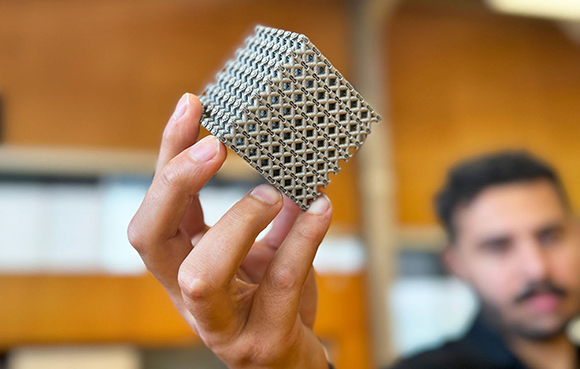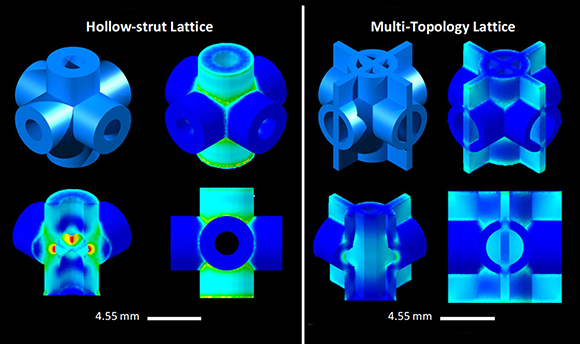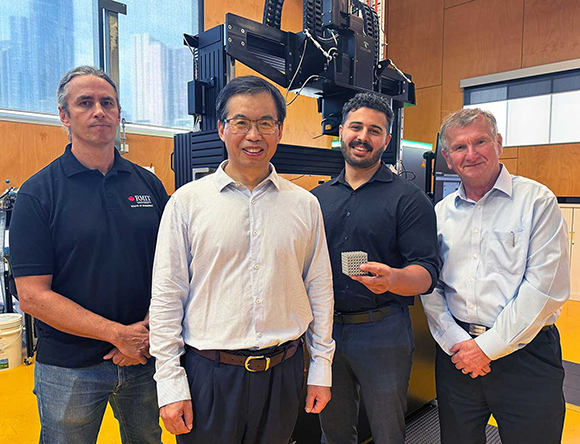RMIT researchers use titanium Additive Manufacturing to create exceptionally high-strength metamaterial
February 27, 2024

Researchers from RMIT University in Australia have reported the development of a new type of metamaterial, additively manufactured from Ti-6Al-4V titanium alloy. Boasting exceptionally high levels of strength for weight, the unique lattice structures have the potential to benefit a wide range of applications, from medical implants to aircraft or rocket parts.
Metamaterial is a term used to describe an artificial material with unique properties not observed in nature. Mechanical metal metamaterials consist of interconnected struts, plates, sheets, or shells with cavity or pore sizes ranging from submillimeter to millimetre scale, usually arranged in repeating units.
The lattice structure designs developed at RMIT are said to have been inspired by nature, where strong, hollow-stemmed plants like the Victoria water lily or organ pipe coral, combine lightness and strength.
However, as RMIT’s Distinguished Professor Ma Qian explained, decades of attempts to replicate these cellular structures in metals have been frustrated by the common issues of manufacturability and load stress concentrating on the inside areas of the hollow struts, leading to premature failures.
“Ideally, the stress in all complex cellular materials should be evenly spread,” Qian explained. “However, for most topologies, it is common for less than half of the material to mainly bear the compressive load, while the larger volume of material is structurally insignificant.”
Metal Additive Manufacturing is said to provide unprecedented innovative solutions to these issues. The RMIT team optimised a new type of lattice structure to distribute the stress more evenly, enhancing its strength or structural efficiency.
“We designed a hollow tubular lattice structure that has a thin band running inside it. These two elements together show strength and lightness never before seen together in nature,” continued Qian. “By effectively merging two complementary lattice structures to evenly distribute stress, we avoid the weak points where stress normally concentrates.”

The design was additively manufactured at RMIT’s Advanced Manufacturing Precinct using Laser Beam Powder Bed Fusion (PBF-LB). Testing showed that the titanium lattice cube was 50% stronger than cast magnesium alloy WE54, the strongest alloy of similar density used in aerospace applications. The new structure had effectively halved the amount of stress concentrated on the lattice’s infamous weak points. The double lattice design also means any cracks are deflected along the structure, further enhancing the toughness.
Study lead author and RMIT PhD candidate, Jordan Noronha, said that they could make this structure at the scale of several millimetres or several metres in size using different types of AM machines. This manufacturability, along with the strength, biocompatibility, corrosion and heat resistance, makes it a promising candidate for many applications from medical devices, such as bone implants, to aircraft or rocket parts.
“Compared with the strongest available cast magnesium alloy currently used in commercial applications requiring high strength and light weight, our titanium metamaterial with a comparable density was shown to be much stronger or less susceptible to permanent shape change under compressive loading, not to mention more feasible to manufacture,” Noronha stated.

The team plans to further refine the material for maximum efficiency and explore applications in higher-temperature environments. While currently resistant to temperatures as high as 350°C, they believe it could be made to withstand temperatures up to 600°C using more heat-resistant titanium alloys, for applications in aerospace or firefighting drones.
“Traditional manufacturing processes are not practical for the fabrication of these intricate metal metamaterials, and not everyone has a laser powder bed fusion machine in their warehouse,” he said. “However, as the technology develops, it will become more accessible and the printing process will become much faster, enabling a larger audience to implement our high-strength multi-topology metamaterials in their components. Importantly, metal 3D printing allows easy net shape fabrication for real applications.”
The full paper, published in Advanced Materials, is available to read here.
Download Metal AM magazine

















